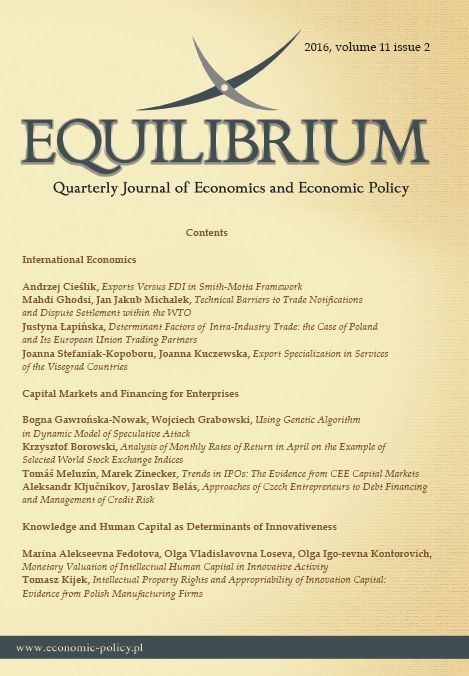Analysis of monthly rates of return in April on the example of selected world stock exchange indices
DOI:
https://doi.org/10.12775/EQUIL.2016.014Keywords:
market efficiency, financial market seasonality, market anomalies, April effectAbstract
The article presents a study of the effectiveness of 22 selected stock indices with the use of the rates of return in the month of April. The portfolio replicating the stock index was bought at the closing prices on the last session in March, and sold at the closing prices on the last session in April. The presence of market inefficiency is demonstrated in cases of the following indices: All-Ord, AMEX, BUX, CAC40, DAX, DJIA, DJTA, DJUA, EOE, FTSE100, SMI, SP500, but for the following indices: B-Share, Bovespa, Buenos, Hang-Seng, MEX-IPC, Nasdaq, Nikkei, Russel, TSE and WIG, the obtained monthly rates of return were statistically equal to zero. In the last part of the article, the correlation coefficients of rates of return for analyzed indices in month of April were surveyed.
Downloads
References
Ariel, R. (1990). High Stock Returns Before Holiday: Existence and Evidence on Possible Causes. Journal of Finance, 45(5). DOI: http://dx.doi.org/10.1111/ j.1540-6261.1990.tb03731.x.
Bernstein, J. (1996). Cykle giełdowe, Warszawa: WIG-Press.
Buczek, S. (2005). Efektywność informacyjna rynków akcji. Teoria a rzeczywistość. Warszawa: Szkoła Główna Handlowa w Warszawie.
Choudhry, T. (2001). Month of the Year Effect and January Effect in Pre-WWI Stock Returs: Evidence from Non-linear GARCH. International Journal of Finance & Economics, 6.
Clare, A., Psaradakis, Z. & Thomas, S. (1995). An Analysis of Seasonality in the UK Equity Market. Economic Journal, 429(105). DOI: http://dx.doi.org/ 10.2307/2235499.
Connolly, R. (1989). An Examination of the Robustness of the Weekend Effect. Journal of Financial and Quantitative Analysis, 24(2). DOI: http://dx.doi.org/10.2307/2330769.
Connolly, R. (1991). A Posterior Odds Analysis of the Weekend Effect. Journal of Econometrics, 49. DOI: http://dx.doi.org/10.1016/0304-4076(91)90010-B.
Corhay, A., Hawawini, G. & Michel, P. (1988). Stock Market anomalies. Cambridge: Cambridge University Press.
Czekaj, J., Woś, M. & Żarnowski J. (2001). Efektywność giełdowa rynku akcji w Polsce. Warszawa: Wydawnictwo Naukowe PWN.
Dyl, E., & Maberly, D. (1989). A Possible Explanation of the Weekend Effect. Financial Analyst Journal, 44. DOI: http://dx.doi.org/10.2469/faj.v44.n3.83.
Fama, E. (1970). Efficient Capital Markets; a Review of Theory and Empirical Work. Journal of Finance, 25(2). DOI: http://dx.doi.org/10.2307/2325486.
Fountas, S. & Konstantinos, S. (2002). Emerging Stock Markets Return Seasonalities: the January Effect and the Tax-loss Selling Hypothesis. Applied Financial Economics, 12(4). DOI: http://dx.doi.org/10.1080/09603100010000839.
French, K. (1980). Stock Returns and Weekend Effect. Journal of Financial Economics, 8 (1). DOI: http://dx.doi.org/10.1016/0304-405X(80)90021-5.
Gu, A. (2003). The Declining January Effect: Evidence From U.S. Equity Markets. Quarterly Review of Economics and Finance, 9(2). DOI: http://dx.doi.org/10. 1016/S1062-9769(02)00160-6.
Gultekin, M. & Gultekin, B. (1983). Stock market seasonality: international evidence. Journal of Finance, 12.
Hasan, T. & Raj, M. (2001). An Examination of the Tax Loss Selling Behavior in a de-regulated Pacific Financial Market. American Business Review, 19.
Hirsch, Y. (1987). Don?t Sell Stock on Monday. New York: Penguin Books.
Jaffie, J., Westerfield, R. & Ma, C. (1989). A Twist on Monday Effect in Stock Prices: Evidence from the US and Foreign Stock Markets. Journal of Banking and Finance, 13(4-5). DOI: http://dx.doi.org/10.1016/0378-4266(89)90035-6.
Jajuga, K. & Jajuga, T. (2006). Inwestycje. Warszawa: Wydawnictwo Naukowe PWN.
Kato, K., Schwarz, S. & Ziemba, W. (1990). Day of the Weekend Effects in Japanese Stocks, Japanese Capital Markets. New York: Ballinger.
Keim, D. (1983). Size-related Anomalies and Stock Return Seasonality: Further Empirical Evidence. Journal of Financial Economics, 12(1). DOI: http://dx.doi.org/10.1016/0304-405X(83)90025-9.
Kim, C. & Park, J.(1994). Holiday Effects and Stock Returns: Further Evidence. Journal of Financial and Quantitative Analysis, 29(1). DOI: http://dx.doi.org/10.2307/2331196.
Lakonishok, J. & Maberly, E. (1990). The Weekend Effect: Trading Patterns of Individual and Institutional Investors. Journal of Finance, 45(1). DOI: http://dx.doi.org/10.2307/2328818.
Lakonishok, J. & Smidt, S. (1988). Are Seasonal Anomalies Real?. Journal of Financial Economics, 13. DOI: http://dx.doi.org/10.1016/0304-405X(84) 90008-4.
Li, B. & Liu, B. (2010). Monthly Seasonality in the New Zealand Stock Market. International Journal of Business, Management and Economic Research, 1(1).
Nowakowski, J. & Borowski, K. (2005). Zastosowanie teorii Carolana i Fischera na rynku kapitałowym. Warszawa: Difin, Warszawa.
Penman, S. (1987). The Distribution of Earnings News over Time and Seasonalities in Aggregate Stock Returns. Journal of Financial Economics, 18. DOI: http://dx.doi.org/10.1016/0304-405X(87)90039-0.
Raj, M. & Kumari, D. (2006). Day-of-the-week and Other Market Anomalies in the Indian Stock Market. International Journal of Emerging Markets, 1(3). DOI: http://dx.doi.org/10.1108/17468800610674462.
Raj, M. & Thurston, D. (1994). January or April? Test of the Turn-of-the-year-effect in the New Zealand Stock Market. Applied Economics Letters, 1(5). DOI: http://dx.doi.org/10.1080/135048594358195.
Reinganum, M. & Shapiro, A. (1987). Taxes and Stock Return Seasonality: Evidence from the London Stock Exchange. Journal of Business, 60(2). DOI: http://dx.doi.org/10.1086/296396.
Rogalski, M. (1984). Discussion to Keim and Stambaugh. Journal of Finance, 3.
Rozeff, M. & Kinney, W. (1976). Capital Market Seasonality: the Case of Stock Returns. Journal of Financial Economics, 3(4). DOI: http://dx.doi.org/10.1016/ 0304-405X(76)90028-3.
Simson, E. (1988). Stock Market Anomalies. Cambridge: Cambridge University Press.
Schwert, W. (2002). Anomalies and Market Efficiency. Simon School of Business Working Paper, FR 02-13. DOI: http://dx.doi.org/ 10.2139 /ssrn.338080.
Szyszka, A. (2007). Wycena papierów wartościowych na rynku kapitałowym w świetle finansów behawioralnych. Poznań: Wydawnictwo Akademii Ekonomicznej w Poznaniu.
Thaler, R. (1987). Seasonal Movements in Security Prices II: Weekend, Holiday, Turn of the Month and Intraday Effects. Journal of Economic Perspectives, 1. DOI: http://dx.doi.org/10.1257/jep.1.2.169.






